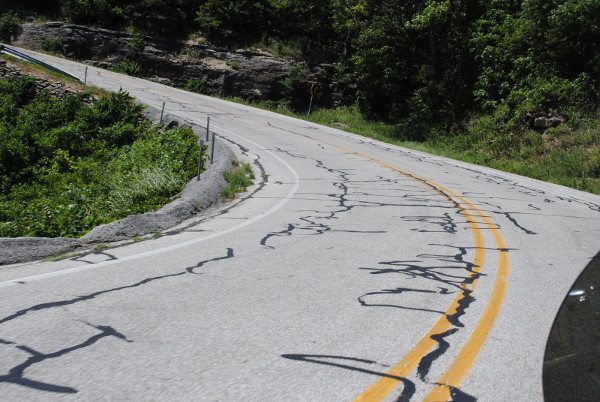
Grass Clippings and Other Road Hazards
Sport Touring Corner
By Norm Kern
Spring has finally arrived, bringing some of the best riding weather of the year- nice and warm but not yet hot and sticky. Along with all the bikes out on the road, lawn mowers are coming out of storage to cut rapidly growing grass as well. Riding through the countryside this time of year, I might see as many as twenty or thirty places with grass clippings on the road in a single day of riding.
Grass Clippings and plant debris in the road are a hazard to motorcyclists and it's against the law to leave them there, isn't that right? While it is true there are some municipalities that have ordinances about this, the closest you can get in the Ohio Revised Code is ORC 4511.74 Placing injurious material on highway, that reads in part:
(A) No person shall place or knowingly drop upon any part of a highway, lane, road, street, or alley any tacks, bottles, wire, glass, nails, or other articles which may damage or injure any person, vehicle, streetcar, trackless trolley, or animal traveling along or upon such highway, except such substances that may be placed upon the roadway by proper authority for the repair or construction thereof.
To get the police to cite someone or bringing an action yourself, you'd have to prove that grass clippings meet the above definition. In rural areas where the problem is greatest, that is probably a stretch. Before we talk about dealing with the grass clipping problem, let's take a look at another inevitable hazard we can count on encountering this spring.
Loose Gravel comes from a number of sources, and it seems like it's most often found in the places that are worst for motorcyclists- in corners and at intersections. Counties that have lots of rural roads are not always good about plowing them when it snows, and because salt dissolves quickly, they spread gravel on the roads on hills and at intersections to help vehicles gain traction in snowy and icy conditions. This gravel stays around even in dry conditions on lightly traveled roads, lasting all winter, saving money and effort. Unfortunately in the Spring, most of it is still there, creating a hazard in exactly the place where motorcyclists need to stop or turn.
The second loose gravel area is in right-hand corners. Trucks, often towing trailers, cut corners, especially on narrow roads. The rear truck and trailer tires go off the pavement onto the shoulder, dragging gravel onto the pavement. Often, so much gravel gets dragged out in the corners, it leaves a big depression on the shoulder, so road crews come out in the Spring and fill them back in. Road crews know there will be some settling and gravel's going to be dragged back out anyway, so they dump extra gravel on the shoulder for good measure. I call this the annual "Refilling of the Gravel Dispensers."
Another loose gravel hazard comes from driveways along the sides of the road, especially uphill ones, after a hard rain washes gravel and debris down them and out onto the road. The debris frequently includes mud, sand and silt which can be more slippery than gravel. Long after the mud is gone, small amounts of sand and silt can remain on the road and be treacherous.
How to handle grass clippings and loose gravel
You're probably getting tired of hearing me say this but, directed practice of your riding skills and developing situational awareness are keys to survival. Dealing with loose surfaces is an important part of your riding skills toolkit.
Maximize your eyesight. There is no substitute for good eyesight when riding a motorcycle. If you have less than perfect vision, get prescription glasses and wear them. At the same time, protect your eyes from excess airflow. If they are dried out and scratchy, you won't see as well. Keep glasses and shields clean.
Learn to read pavement. Riders are scared and outraged by grass clippings, but at least they are easy to see. The real test is being able to see bits of sand and silt in corners, and that requires experience as well as good eyesight. Don't ride faster than the range of your pavement analysis. If you are cresting a hill or hump where you can't see the road ahead or coming up on a blind corner, slow down!
Know your lines. You should always be looking at alternate lines and analyzing their pros and cons, so you have a choice if you have to take evasive action.
Preparation. Don't fixate on an obstacle- keep your eyes on the best path around or through. If you are still in an area of good traction, apply the brakes and get rid of as much speed as possible, but release them before you reach the obstacle so you can coast around or through it.
Relax, and if possible, take a straight line through the obstacle itself. If you are coasting in a straight line and lose traction, gyroscopic effect of the rotating wheels and directional momentum of the bike will keep it upright and going in a straight line.
If that sounds like a lot to remember, it is. That's why you need to practice these techniques and commit them to muscle memory so it becomes automatic. Then your brain is free to concentrate on other unexpected stuff that is bound to happen.
Tar Snakes, narrow strips of crack sealant, are applied to prevent roads from cracking further and requiring complete re-pavement. I've ridden many roads with tar snakes that cause no problem at all, even on a hot day.
Unfortunately, the increased use of sealant made from tar mixed with scrap rubber, combined with inept application, (where the sealant is applied several times thicker than needed) makes for slippery riding, especially on a hot day. Tar snakes are usually slippery when wet, so they can be a hazard even when it's cool.
Unlike intermittent hazards like grass clippings and gravel, tar snakes can go on for miles. Two things make them especially hazardous. First is their completely random pattern. There might be a few, but a mile later they could be all over the road. Sometimes they run across the road, sometimes in parallel with your direction of travel. Some are straight and some zigzag all over.
Second is the extreme variation in traction- the pavement of the road has normal traction while the tar snakes on it seem to have no traction at all. Whenever your tire gets on a tar snake, it starts sliding. A fraction of a second later it meets good pavement and abruptly quits sliding. Tire snakes drive people crazy! Here's how to deal with them:
Preparation. Your bike is going to squirm when you ride tar snakes on a hot day, so you need to get used to it. A great way to do that is find a stretch of highway with rain grooves that run parallel to the direction of travel and make your bike feel like it has a flat tire. Ride the rain grooves until you can completely relax with the bike shifting around under you. Move slowly side to side within the lane to another to aggravate the effect. You'll learn that just because the bike shifted under you doesn't mean it's going down or you need to be scared. With this added confidence, you'll be able to concentrate on effective navigation rather than fear the next time you encounter tar snakes.
Navigation. There are two goals- first, try to minimize the percentage of the time your tires are on the tar snakes. This involves picking the part of the lane that is clearest most of the time. More traction equals less squirm. Second, minimize the length of time your tire is continuously on a tar snake. For example, let's say the left side of your lane only has 25% of the surface covered by tar snakes but they run in the direction of your travel. The right side has 50% of the surface covered by tar snakes but they are two inches wide mostly running across the lane at a right angle to your direction of travel. In this example, the right side will probably be more to your liking because the tires get more frequent corrective moments of full traction.
Riding season is finally here. Get out, enjoy it and keep the road hazards away from your path. Happy riding!
---------------------------------------------------------------
Motorcycle Sport Touring Association Rallies and activities for May
Tri-STAR Rally
When: May 25-28, 2018
Where: Allegheny Inn, Sparta, North Carolina
Description: For some people, Memorial Day weekend means the Indianapolis 500 car race, but to MSTA members, it's the MSTA TriSTAR weekend. The rally is called TriSTAR because of its location in Sparta, North Carolina, which is very close to neighboring states Virginia to the north and Tennessee to the west.
Rooms at the host hotel open out to the parking area. Shelters are set up for the festivities, which include a Friday night cookout and banquet on Saturday night.
Weather is usually pleasant that time of year and of course there are many great roads to ride in the area. Complete information is available on the TriStar web site at http://msta-se.com/tristar/
Connect with local Ohio MSTA riders at these monthly breakfasts:
Southwest Ohio Breakfast, May 19
Village Family Restaurant
144 S. Main St.
Waynesville, OH 45068
Central Ohio Breakfast, June 3
Portside Cafe
6515 S High St
Lockbourne, OH 43137



